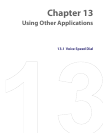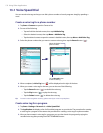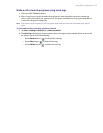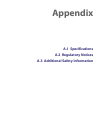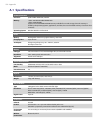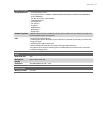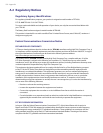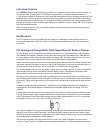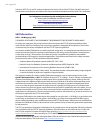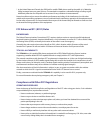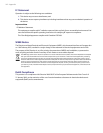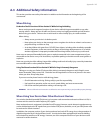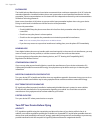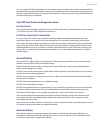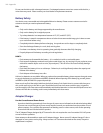
Appendix 139
BODY-WORN OPERATION
Your TITA100 PDA phone was tested for typical body-worn operations with the back of the device kept 1.5
cm from the body. To comply with FCC RF exposure requirements, a minimum separation distance of
1.5 cm must be maintained between the user’s body and the back of the device, including the antenna. Third-
party belt-clips, holsters and similar accessories containing metallic components should not be used. Body-
worn accessories that cannot maintain 1.5 cm separation distance between the user’s body and the back of
the device, and have not been tested for typical body-worn operations may not comply with FCC RF exposure
limits and should be avoided.
When carrying the device on you, turning the display in towards the body will minimize RF exposure and
maximize antenna efficiency.
Modifications
The FCC requires the user to be notified that any changes or modifications made to the device that are
not expressly approved by High Tech Computer Corporation may void the user’s authority to operate the
equipment.
FCC Hearing-Aid Compatibility (HAC) Regulations for Wireless Devices
On July 10, 2003, the U.S. Federal Communications Commission (FCC) Report and Order in WT Docket 01-
309 modified the exception of wireless phones under the Hearing Aid Compatibility Act of 1988 (HAC Act)
to require digital wireless phones be compatible with hearing-aids. The intent of the HAC Act is to ensure
reasonable access to telecommunications services for persons with hearing disabilities.
While some wireless phones are used near some hearing devices (hearing aids and cochlear implants), users
may detect a buzzing, humming, or whining noise. Some hearing devices are more immune than others to
this interference noise, and phones also vary in the amount of interference they generate.
The wireless telephone industry has developed a rating system for wireless phones, to assist hearing device
users find phones that may be compatible with their hearing devices. Not all phones have been rated.
Phones that are rated have the rating on their box or a label located on the box.
The ratings are not guarantees. Results will vary depending on the user’s hearing device and hearing loss.
If your hearing device happens to be vulnerable to interference, you may not be able to use a rated phone
successfully. Trying out the phone with your hearing device is the best way to evaluate it for your personal
needs.
M-Ratings: Phones rated M3 or M4 meet FCC requirements and are likely to generate less interference to
hearing devices than phones that are not labeled. M4 is the better/higher of the two ratings. TITA100 is
rated M3.
Hearing devices may also be rated. Your hearing device manufacturer or hearing health professional may
help you find this rating. Higher ratings mean that the hearing device is relatively immune to interference
noise. The hearing aid and wireless phone rating values are then added together. A sum of 5 is considered
acceptable for normal use. A sum of 6 is considered for best use.
In the above example, if a hearing aid meets the M2 level rating and the wireless phone meets the M3 level
rating, the sum of the two values equal M5. This should provide the hearing aid user with “normal usage”
while using their hearing aid with the particular wireless phone. “Normal usage” in this context is defined as a
signal quality that is acceptable for normal operation.
The M mark is intended to be synonymous with the U mark. The T mark is intended to be synonymous
with the UT mark. The M and T marks are recommended by the Alliance for Telecommunications Industries



